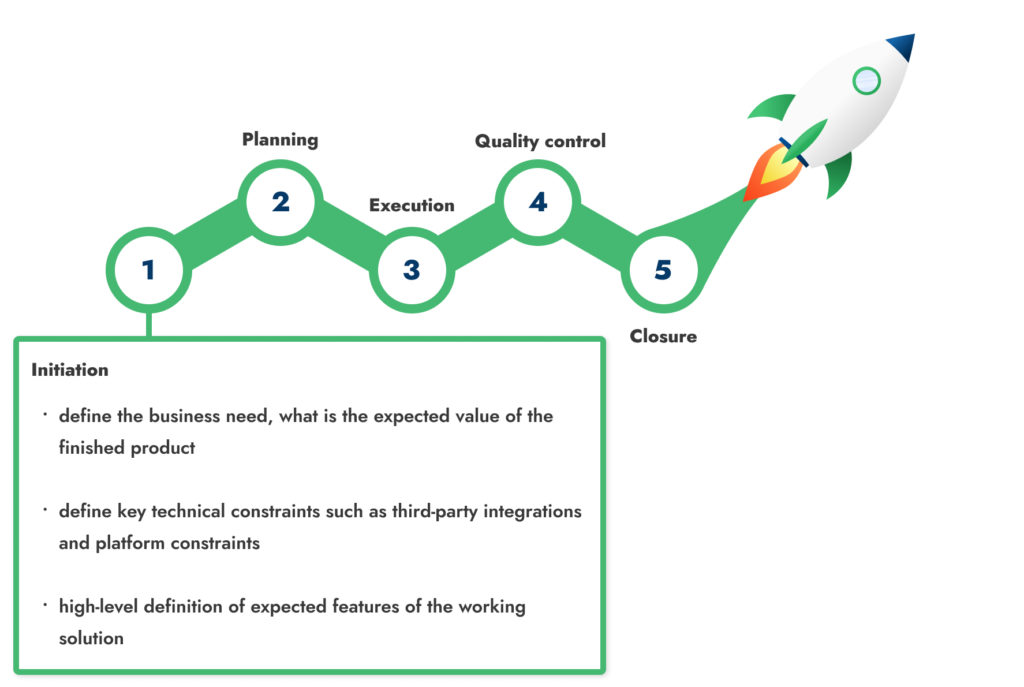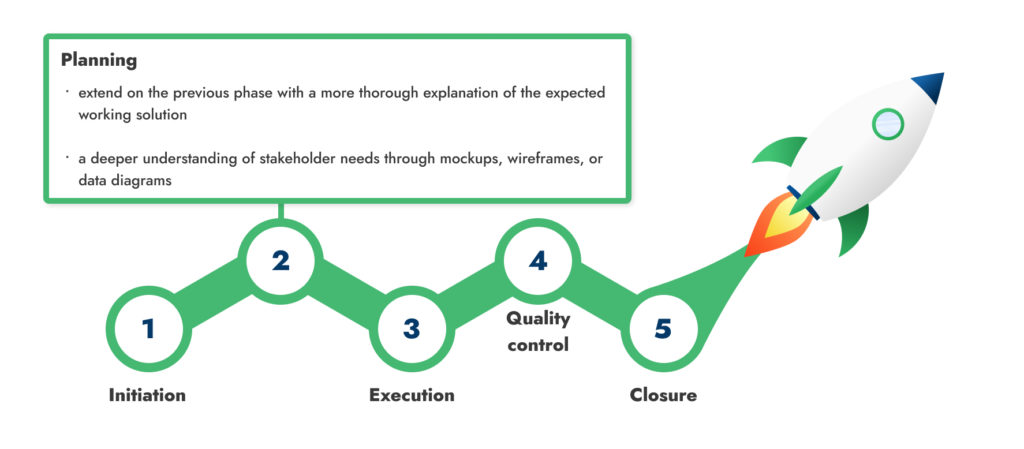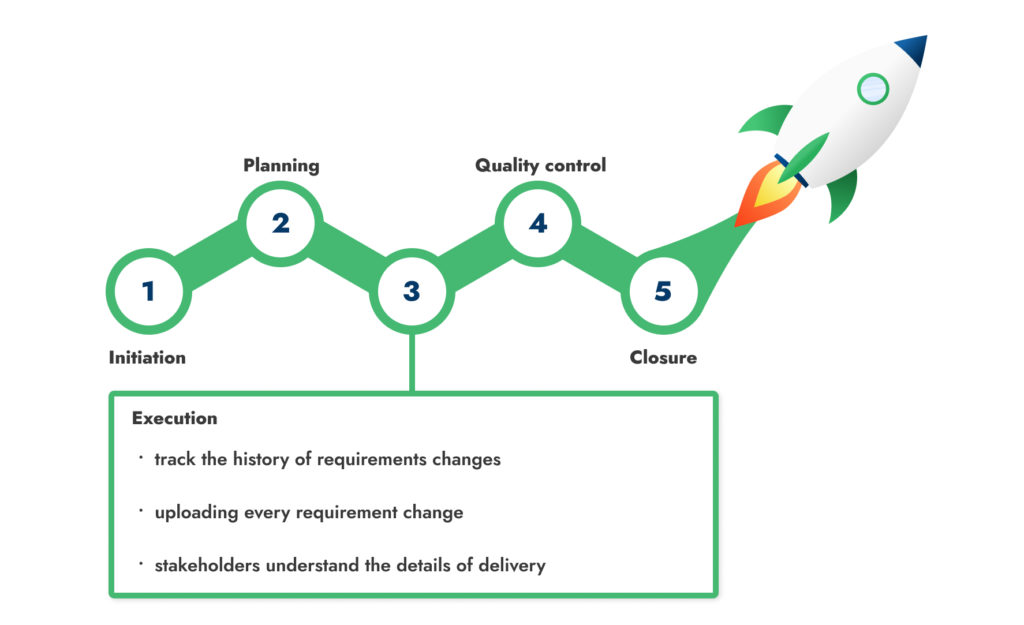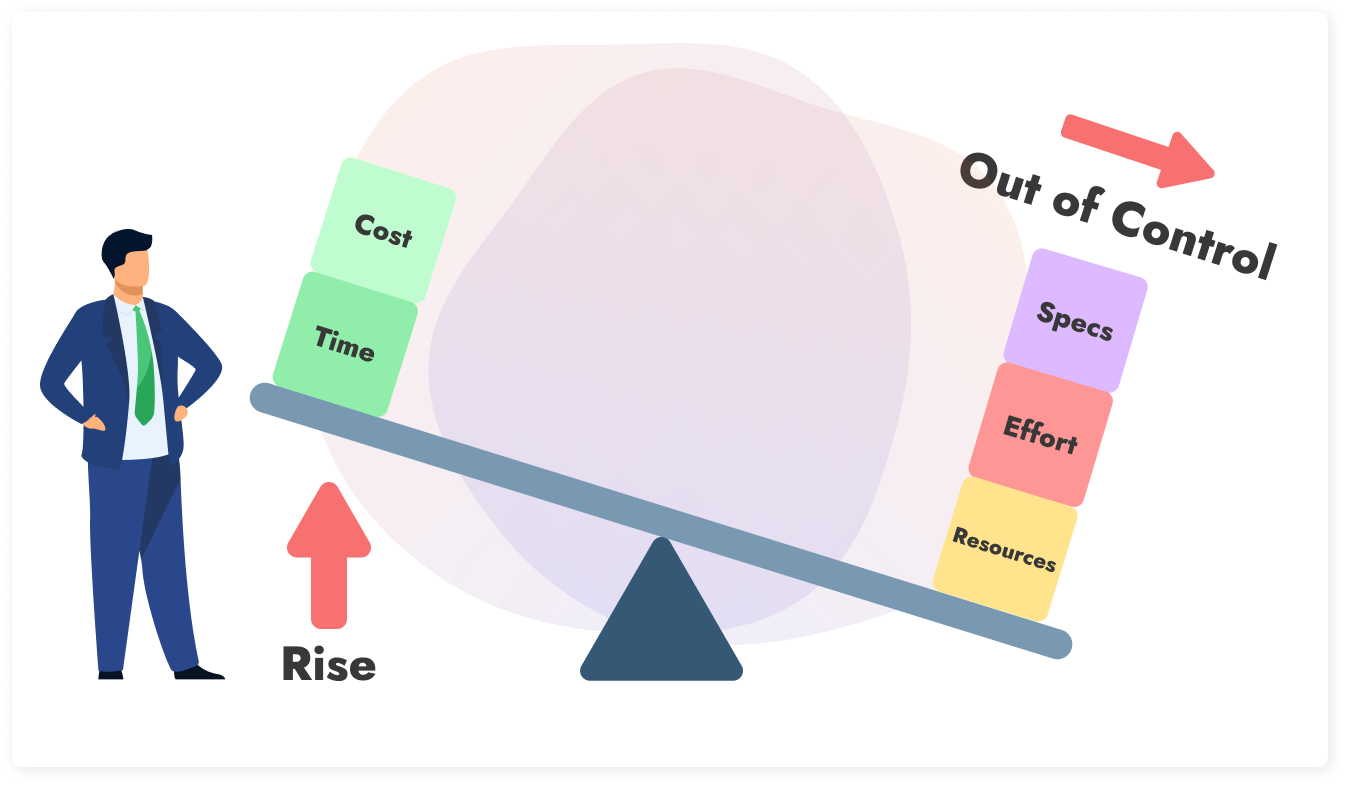Written Project Requirements in Project Phases

Why do more and more teams forget about written project requirements?
Project requirements give a big picture of the project. On the contrary, tasks in Agile gradually introduce you to the product. Gradual information helps to focus on a specific task, instead of the overwhelming big picture.
Adapting to market and product changes can be crucial for finishing the project. Yet, none of these is the opposite of written project requirements in project phases. However, many people connect Agile and no documentation. That is one of the reasons why Agile isn’t sufficient in 2021.
In our experience, the risk of project failure often lies in broken communication and the loss of subtle important details. So, when the stakeholder or developer would want to check out the higher picture, where would they find it?
Here we will discuss the benefits of specified documentation in every project stage.
Project management life cycle overview
Product development life cycle in software project management is a set of stages that make a project from idea to launching. They are initiation, planning, execution, quality control, and closure.
However, these phases are not the same in standard development and in Agile. In Agile, all of them are repeating multiple times.

Further, a successful strategy means having a good implementation of each of the project phases. According to Project Management Institute Research, almost 10% of every dollar spent by businesses is lost through the ineffective implementation of business strategy.
Strictly speaking, for every $1 billion invested in the projects, $122 million is lost due to flawed project management. That means that to avoid losses, every stage should be planned carefully.
Initiation
The first of four stages is initiation. Initiation is a phase of the project management life cycle where you identify the business need. Here is where you name the problem, ways of solution, seize the opportunity. In this phase, you define the main conditions and requirements. Also, here you decide if the project is workable and what the major deliverables are.
In this phase, your written project requirements should contain the most important segments of your expected working solution.
You will define major technical constraints like the technology stack, very high-level architectural diagrams, and third-party integrations.
Also, you should document high-level deliverables from a working software perspective. That means only the bigger segments of the final solution without technical or functional requirements.
In practice, this can be 2-3 pages that provide enough information to start the conversation and show the potential complexity of the expected solution.
This information should be shared with all known parties in the project. That way everyone understands the scope and potential early risks.

Also, this will serve as the foundation for the upcoming phases.
Planning
Once your project is authorized and funded, you go one step forward. You go to planning. Planning is a phase of the project management life cycle (PMLC) responsible for breaking down the main requirements into smaller tasks. Breaking down the project into smaller tasks is also called decomposition in project management. Here is where you share the roles, build a team, make a schedule for the realization of assignments.
When creating smaller tasks, you should follow INVEST agile approach. Tasks should be achievable within the time frame and easy to understand.
In order to efficiently plan any kind of delivery, you need more detail about your expected solution. The planning should contain activities to improve the sprint velocity. Specifically, that means cutting the unnecessary, choosing helpful tools, and learning from the retrospective.
This phase is where you spend more time to deeply understand the needs of the stakeholders. You should know the expectations and the constraints your team reports on. This does not mean you should define everything in extreme detail. It does mean you should extend on to the previous phase with a more thorough explanation of the expected working solution. While doing it, keep in mind the business need!

Why to have written documentation in Planning?
You will extend your core information from the previous phase. Usually, it goes with mockups, wireframes, or data diagrams. They help to iterate with the stakeholders on conceptual suggestions about the business needs.
As your knowledge of the project deliverability grows, your requirements grow. Further, the number of communication tools for storing information also grows.
For long-term project success, it’s important to maintain this knowledge in one place. For example, a single source of truth for stakeholders and the team is concise and easily reachable.
In practice, this is where projects start to lose clarity of what is the last known set of deliverables. You add the team members and introduce changes. Communication happens across multiple people and tools. That way, communication doesn’t streamline.
Keeping everyone on the same page in this phase is paramount. This is the phase where the initial timeline, budgets, and team size are discussed. Missing crucial information can lead to delays. Also, missing crucial information can cause overpromising, under-delivering, and losing credibility.
How to make planning easier?
JadeALM was created to easily navigate the ever-changing landscape of written project requirements. It covers the gap between changing requirements and project planning.
Gantt timeline tool in JadeALM is directly connected with the requirements document. Automatically updates of changes or adding give you confidence that your plans are relevant. Even in the very likely event of last-minute requirements changes, you are still updated in time.
Execution
The only thing that can go after a good plan, is a good job. Execution is a stage where you put plans into action. Here is important to keep tasks on track, have a good organization of work, and meet deadlines. Communication between different project representatives plays a great role. These roles can be project managers, developers, clients, and stakeholders.
No matter how good are your project requirements in the previous steps, you should always count on upcoming changes. They can happen because some technical workarounds aren’t noticeable before you start working on them.
Another reason for changes is if some features are no longer necessary. Also, change can happen if we decide to work on the feature with different user experiences.
The struggle comes when you need to manually upload every requirement change in every view. The more changes you have, the harder is to follow the original context and plan.

They also require a lot of time to track the history of requirements changes. Currently, no project management tool provides a solution for tracking the history of requirements changes. With Jade, you can see it when you open requirement details, similar to Google Docs.
Automatic updates through all views keep everyone from your team on the same page. A high level of written project requirements also makes stakeholders understand the details of delivery.
Quality Control
After you have finished the tasks from Execution, you have to check if the features you made are working properly. Quality control is a step in PMLC that presents a set of activities for ensuring the functionality of the product. The goal of this phase is to find and resolve potential bugs and issues.
Here, the project manager ensures that the tasks are solving according to the plan. Deliverables must be produced on time, on budget, and of sufficient quality. Project managers often use other tools for quality control. While uploading issues and bugs in the primary PM tool, they lose time and energy while switching more tools to note one issue. There is a lot of issue tracking challenges to consider while managing quality control.
JadeALM converts every issue discovered in QA into a task and updates it in every view.

Closure
Closure of a project includes one deliverable – final report. Project Management tools have an option to create a final report as well. JadeALM can easily include all the steps that have been done throughout the project. Editor tool makes you overview and connect all tasks in a final report.
Last but not the least
Having documentation of the project makes the project more formal. Your team works on something that is “tangible” because you have a paper that says so.
Placing requirements in a document – even with a possibility that many of them will change – increases commitment. It gives a feeling of formality and a formal feeling to finish the tasks.
Not having all documentation at once leaves space for awkward situations. It can get you into losing important information or track what is finished. Or, your team can complete some tasks but you won’t know because there is no documentation with a description of how they should look when they are done. Inclarity of progress makes the team lose interest.
We hope your team wouldn’t lose interest the same you didn’t while reading this article. For extra questions, feel free to reach out! 😀



